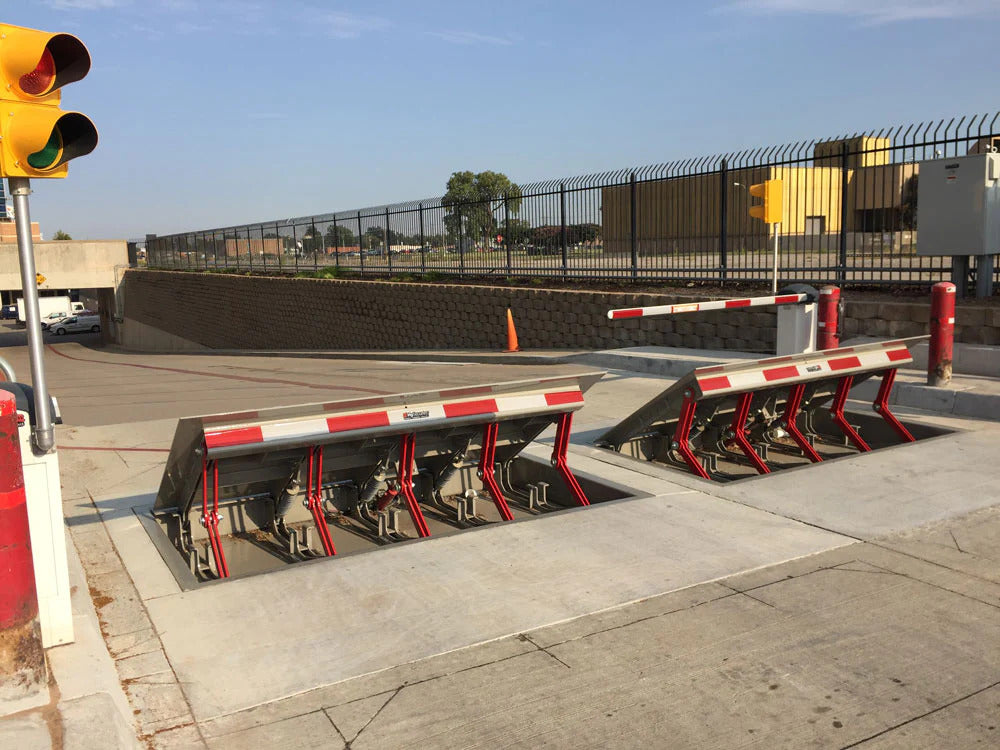More About Wedge Barriers
The Ultimate Guide To Wedge Barriers
Table of ContentsNot known Facts About Wedge BarriersSome Known Factual Statements About Wedge Barriers

The 3-Minute Rule for Wedge Barriers
The staying force used to
the cam camera deploy the wedge plate 16 may might provided offered an electromechanical actuator 84 or other various other. The springtime assembly 54 and the actuator 84(e. Wedge Barriers. g., electromechanical actuator)might run with each other to equate the web cam and lift the wedge plate 16.
As stated above, the springtime setting up 54 exerts a continuous pressure on the web cam, while the electromechanical actuator may be managed to apply a variable force on the cam, thereby allowing the training and lowering( i. e., releasing and retracting )of the wedge plate 16. In specific personifications, the continuous force applied by the spring setting up 54 may be flexible. g., electromechanical actuator) is disabled. As will certainly be valued, the springtime assembly 54 might be covered and shielded from particles or other aspects by a cover plate(e. g., cover plate 68 displayed in FIG. 4) that may be considerably flush with the raised surface 38 of the foundation 14. As discussed over, in the released placement, the wedge plate 16 serves to block access or travel past the barrier 10. As an example, the obstacle 10(e. g., the wedge plate 16 )might obstruct pedestrians or cars from accessing a property or path. As reviewed over, the obstacle 10 is connected to the anchor 30 secured within the structure 14,

front braces 71. Consequently, the link assemblies 72 might pivot and revolve to allow the collapse and expansion of the linkage my response settings up 72 during retraction and deployment of the bather 10. The link settings up 72 cause movement of the wedge plate 16 to be limited. For instance, if a car is taking a trip in the direction of the released wedge plate 16(e. For example, in one scenario, the safety and security legs 86 might be extended throughoutmaintenance of the obstacle 10. When the safety legs 86 are deployed, the safety and security legs 86 sustain the weight of the wedge plate 16 versus the surface area 12. As an outcome, the training mechanism 50 may be shut off, serviced, gotten rid of, changed, etc. FIG. 5 is partial perspective sight of an embodiment of the surface-mounted wedge-style barrier 10, showing the web cam 80 and the cam surface areas 82 of the training system 50. Especially, 2 webcam surfaces 82, which are described as lower camera surface areas 83, are placed listed below the cam 80. The lower webcam surface areas 83 may why not look here be fixed to the surface 12 (e. As an example, the reduced web cam surfaces 83 and the placing plate 85 may form a single item that is protected to the support 30 by screws or various other mechanical fasteners. Furthermore, two camera surfaces 82, which are described as top cam surface areas 87, are placed over the cam 80 and paired to (e. In various other personifications, stepping in layers or plates might be positioned between the surface area 12 and the reduced cam surface areas 83 and/or the wedge plate 16 and the view publisher site upper cam surfaces 87 As discussed over, the cam
80 translates along the cam surfaces 82 when the wedge plate 16 is raised from the pulled back setting to the released position. Furthermore, as discussed over, the spring assembly 54 (see FIG. 3 )might supply a force acting upon the webcam 80 in the direction 102 using springtime rod 58, which may reduce the pressure the electromechanical actuator 84 is called for to apply to the web cam 80 in order to actuate and lift the wedge plate 16. 1 )to the released placement(see FIG. 4). As shown, the camera 80 includes track wheels 104(e. g., rollers), which get in touch with and convert along the camera surface areas 82 during operation.